Friday February 20, 2015
Collier Seminole State Park
Naples, Florida
We almost never leave the park on week-ends and this one was no exception. But on Friday, we did go 3 miles down the road to a hike the Marsh Trail at the 10,000 Islands National Wildlife Refuge. The Refuge was established in 1996 under the November 18, 1988 "Arizona-Idaho Conservation Act". I had no idea what this was and I’m not sure I still do, but here’s what I found about it on line. Let me know if it makes sense to you.
This act directed the exchange of 68.4 acres of land at the Phoenix Indian School in Arizona for 107,800 acres of land in Collier County, Florida, and $34.9 million, from corporations owned by the Collier family. In addition to extensive provisions for implementation of the exchange and use of the funds to benefit Arizona Indian Tribes, the law directed that 80,070 acres of the Florida land be added to the Big Cypress National Preserve, 5,109 acres be added to the Florida Panther National Wildlife Refuge, and 19,620 acres be used to establish a new Ten Thousand Islands National Wildlife Refuge.
Seems like a big swap that benefitted Florida in a huge way.
In addition to the Marsh Trail, the Refuge which is in orange on the map, the Refuge has 3 canoe trails, the blue lines. During the winter they are quite low. We can see the one that normally goes off from the parking lot is completely dry. But there is a place where the water is deep enough about a 1/4 mile down the trail. If we have time next week and good weather we might use our kayak carts and check it out and look for the put ins on the other two. But for today we are walking the trail.
Right off the bat in one of the canals along the trail we spot a green egret. I just love their spectacular colors and markings. Either this fellow gets around or there are a number of them here in the refuge. I saw them several times all along the trail.
As we walk, ospreys are are flying and calling overhead.
Off to the side as we approach the viewing platform we see the waters are filled with egrets, herons and a lone spoonbill.
We climb the tower to get a long range view.
From here I also spy an anhinga I didn’t see from my ground view.
The tri colored heron is starting to get his breeding plume on the back of his neck. Doesn’t he look handsome?
And of course I can’t resist taking a picture of this Great Egret’s beautiful breeding plumage for which they were almost wiped out when the cost of a pound of their feathers to decorate women’s hats at the turn of the century was more than the cost of a pound of gold.
Finally we come down and walk on down the trail where we get glimpses of the wetlands. We see great blue herons, another little green heron hiding in the mangroves, two white pelicans who fly in as we watch.
We follow along watching a group of blue winged teals moving and eating in their group. They are hard to get pictures of since it seems they have their heads in the water every time I click the picture. I actually try clicking when they put their heads in the water rather than when I can see their heads. That results in at least one decent shot. We didn’t see their blue wing patch at all but they have gorgeous markings.
At one spot we can see dozens of ducks all gathered together for some sort of social event. They are dipping, diving, chattering. A closer look shows them to be a flock or two or three of coots with a few moorhens scattered among them.
High above the fray in the top of a tree was a great blue keeping watch over it all. I guess he must be resting since he is a wading eating and my guess is that the water here is too deep for him. Can you see his dark shadow just to the left of center in the tree tops?
When we reach the end of the trail, we can see that this area in wetter times is damp but not today. The only wildlife here is a beautiful gulf fritillary butterfly enjoying the thistle.
We turn around to head back and off to the right, we find another nice kayak put in but it’s way too far from any parking to take advantage of so I suspect only refuge personnel use it.
It is now several hours later and as we walk back we see some but not all of the same birds. A new addition is a lone mottled duck among the coot group. I notice him particularly because of his bright yellow bill.
It’s as if the birds know this is a National Wildlife Refuge. In many spots birds not of a feather are hanging out not too far from each other. Can you spot the white egret, the great blue, white pelican and little blue?
A moorhen has moved into the picture as I watch.
The great egret’s long, lacy, delicate, flowing breeding plums are so gorgeous. I wonder if they molt out after the season and one might find them.
We’re almost back to the parking lot when this catbird entertains us with some antics.
In the distance we see the red shouldered hawk keeping watch.
Another green heron in the reeds closes out our day at the Wild Life Refuge. This walk is free and open to the public during daylight hours. If you are in this area, don’t miss it.
THE END

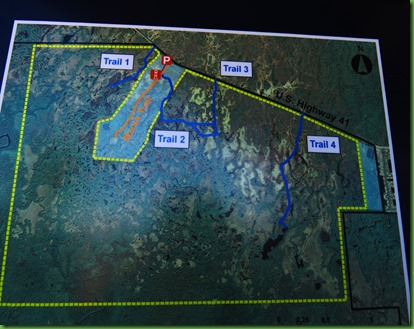











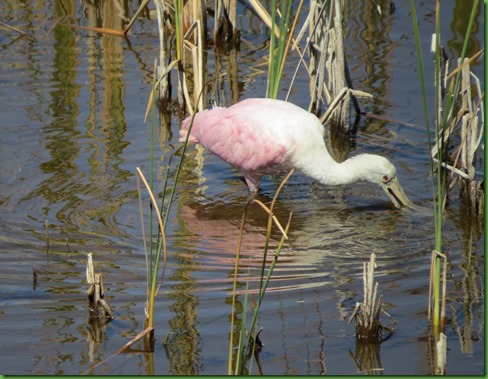




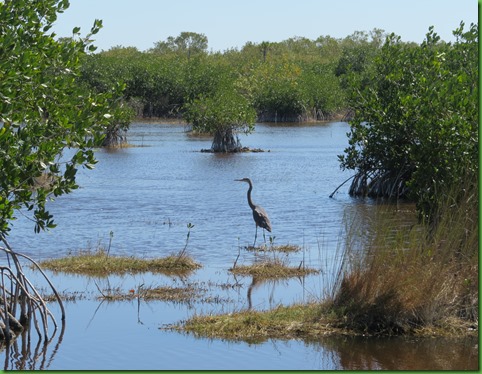


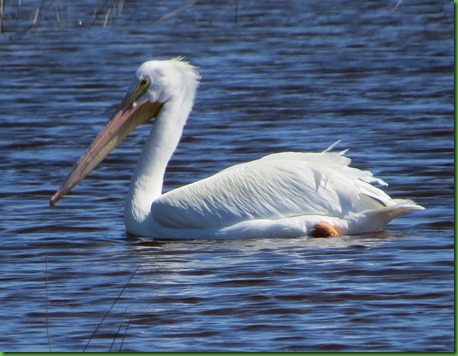













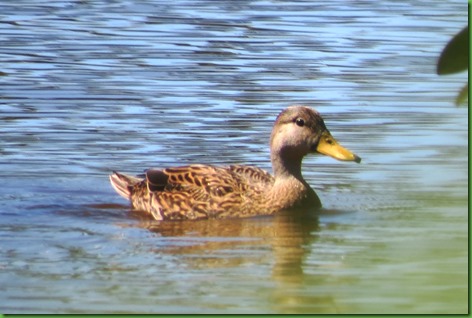











Great photos of all the birds. We love the Ten Thousand Islands refuge. Nice to see it again through your eyes.
ReplyDelete
ReplyDeleteGreat pictures - enjoy your journey to the "river of grass"
Your bird shots are stupendous! Either they or I don't hold still enough for non blurry shots. Once again, another great hike.
ReplyDeleteWhat wonderful bird pictures - I love them - especially the "End"! The green heron and great egret are truly beautiful. And who can not like Spoonbills and Pelicans - so unique. Looks like a great place for birds and birders alike :)
ReplyDeleteQuite a day for birding! Beautiful shots!
ReplyDeleteBack in a former life when I lived in upstate New York and had a spring and fall migration banding station, I began a study on grey catbirds. I wanted to determine if the amount of rufous undertail coverts had any relationship to their age. Sorry to say, IBM moved us to Minnesota before I could draw any conclusions about that.
ReplyDeleteYour 'the end' photo reminded me of that. Studying feathers on that part of a bird's anatomy was messy at times. ;)
I love all the bird photos, but I'm still scratching my head over that land swap.
ReplyDeleteWow!! Jackpot day, for sure!! I can't believe all the gorgeous birds you saw. And you found my favorite, the Roseate Spoonbill:) Love the photo with the reflection:) Those breeding plum feathers blowing in the wind on the Great Egret are so pretty! And four in one photo...what a great capture:) The butterflies were just icing on your cake today!
ReplyDeleteLove the variety of birds! I am immersed in city life for the next week or so, I'll be living the nature life vicariously through you!
ReplyDeleteIncomprehensible land deal that makes no sense to me, but I love what they did with the Florida lands. Terrific photography - love that green heron!
ReplyDeleteNot sure how you "swap" land thousands of miles apart or what Idaho has to do with AZ and FL? Very confusing indeed, but the protection of so many acres in Florida is certainly a nice outcome. I barely know a robin from a woodpecker so your name dropping is very impressive :-) I love all the headless teals in the water.....it must look even funnier from the "under" side! Your zoom always surprises me. That great blue shot is so clear from that distance. Maybe it's his striking color, but the catbird is my favorite :-))))
ReplyDeleteWhat a day for birds. I love the great egrets.
ReplyDeleteI don't think I've never seen a green or a tri-colored heron- so pretty. The egret is gorgeous- I love the first shot of him with his feathers flowing below- it looks like you caught him in motion but perhaps that's the way his feathers are at the bottom. How do you get such good shots like the ones of the osprey flying? If I'd taken it, it would be blurry. Looks like a fun walk! xxxooo
ReplyDeleteLots of birds! Animals are so fun to watch.
ReplyDeleteYour pictures are magnificent, especially of the Osprey in flight! Wow!!!
ReplyDeleteWhat a wonderful day of birding! You're right, the teals are so hard to capture -- they almost always have their heads below water while they're dabbling along searching for food. Another place that's long been on our very long list…..
ReplyDeleteBoy, looks like I'm going to have to get back over to the Marsh Trail soon! It's right down the road from where we're staying on Chokoloskee Island, but we've been so busy with work I haven't made it back in a few weeks. Thanks for sharing!
ReplyDelete~L
Great pictures! A great place to hike and explore.
ReplyDeleteTen Thousand Island Marsh Walk is one of our favorite stops along the Tamiami Trail. We were there just 10 days before you and didn't find nearly the birds that you found. There wasn't one Spoonbill which really surprised us. Your photos are wonderful and reminded me of what we usually see when we visit:o))
ReplyDeleteYour day at the NWR is my kind of day, a hike and birds to admire and photograph. Like you I never stop taking pictures of Herons and Egrets, they are just too beautiful.
ReplyDeleteGreat pics! Looks like a place to see!
ReplyDeleteWow, lots of great bird sightings! And your pictures, as always, are just gorgeous!
ReplyDelete